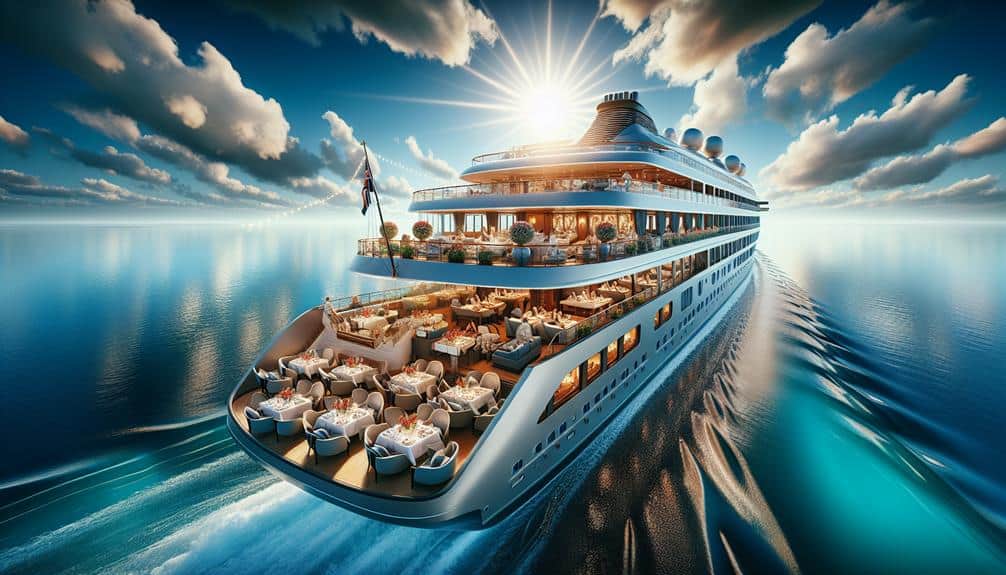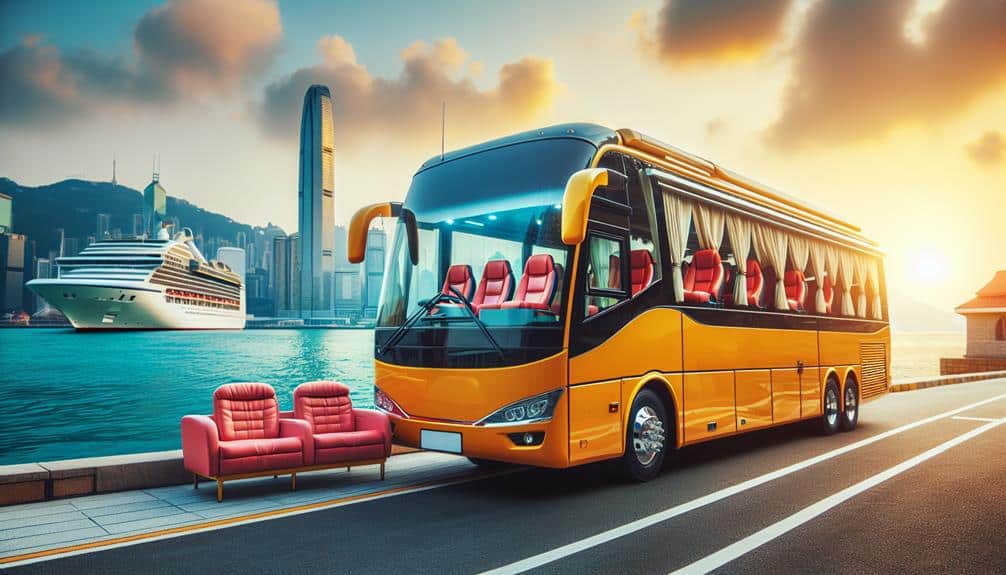Experience a cruise where inclusivity and accessibility shine. Elevator access to all decks guarantees easy navigation. Accessible staterooms cater to specific needs with thoughtful designs and safety features. Wheelchair-friendly public areas offer ramps and lifts for seamless movement. Priority boarding services and tailored assistance make boarding and disembarkation hassle-free. Specialized medical facilities onboard ensure immediate response to health concerns. These features prioritize your comfort and safety throughout your journey.
Key Points
- Elevator access available for passengers with disabilities for easy navigation on all decks.
- Thoughtfully designed accessible stateroom accommodations with emergency call buttons and modifications.
- Wheelchair-friendly public areas with ramps, lifts, and crew assistance for seamless movement.
- Priority boarding services and tailored assistance program for boarding and disembarkation.
- Specialized medical facilities on board for immediate emergency response and quality medical care.
Elevator Access for All Decks
When boarding a cruise ship, you'll find that elevator access to all decks is readily available for passengers with disabilities. This guarantees that individuals with mobility challenges can easily navigate the various levels of the ship without encountering obstacles.
To make the most of this feature, it's essential to understand elevator etiquette. Be mindful of allowing individuals with disabilities to board and exit first, as well as giving priority to those who need the elevator the most.
Additionally, familiarize yourself with the deck layout to optimize your navigation experience. Knowing which deck houses key amenities like dining areas, entertainment venues, and lounges can help you plan your activities efficiently.
Accessible Stateroom Accommodations
Exploring the accessible stateroom accommodations on a cruise ship can greatly enhance your overall experience as a passenger with disabilities. These staterooms are thoughtfully designed to cater to your specific needs, providing a comfortable and convenient space during your voyage. One key feature is the bathroom modifications, which include grab bars, roll-in showers, and adjustable sinks to guarantee ease of use and safety. These modifications are crucial for maintaining independence and ensuring a relaxing stay on the ship.
Moreover, accessible staterooms are equipped with emergency call buttons strategically placed in different areas of the room. In case of any unforeseen circumstances, these buttons allow you to quickly summon assistance. Knowing that help is just a button press away can provide peace of mind and reassurance throughout your journey.
Wheelchair-Friendly Public Areas
To guarantee a seamless experience for passengers with disabilities, cruise ships provide wheelchair-friendly public areas equipped with accessible features and accommodations. Ramp accessibility is a key feature in ensuring ease of movement throughout the ship. Ramps are strategically placed in areas such as dining venues, entertainment areas, and outdoor decks, allowing wheelchair users to navigate these spaces comfortably. These ramps are thoughtfully designed to meet safety standards while blending seamlessly with the ship's aesthetics.
Moreover, wheelchair lifts are installed in locations where stairs might pose a challenge. These lifts provide individuals with mobility impairments a convenient way to access different levels of the ship. Whether you're looking to reach a sun deck, a lounge, or a dining area, wheelchair lifts offer a practical solution. The cruise ship crew is trained to assist passengers in utilizing these lifts efficiently, ensuring a hassle-free experience for all guests with disabilities. With ramp accessibility and wheelchair lifts available, cruise ships prioritize inclusivity and accessibility for passengers of all abilities.
Assistance With Boarding and Disembarkation
Traversing the boarding and disembarkation process on a cruise ship is made seamless and stress-free with dedicated assistance for passengers with disabilities. Here's how cruise lines guarantee you have a smooth experience:
- Priority boarding services: You'll have access to priority check-in and boarding, avoiding long queues and delays.
- Tailored assistance program: A personalized assistance program will be customized to your specific needs, ensuring you receive the support required throughout the boarding and disembarkation process.
- Accessible gangways: Cruise ships provide accessible gangways to facilitate easy boarding and disembarkation for passengers with mobility challenges.
- Reserved seating: Designated seating areas are available for passengers with disabilities during the boarding process to provide comfort and convenience.
- Help from crew members: Trained crew members are always on hand to assist with boarding, disembarkation, and any other aid you may need to navigate the ship smoothly.
Specialized Medical Facilities on Board
Exploring the different amenities and services provided on a cruise ship, one vital aspect to ponder is the presence of specialized medical facilities on board to ensure the well-being of all passengers, including those with specific health needs. These onboard medical care centers are equipped with trained professionals and essential equipment to handle a range of health concerns that may arise during your voyage.
In the event of an emergency, cruise ships are well-prepared to provide immediate and effective emergency response. The medical facilities onboard are often equipped to handle minor injuries, illnesses, and more serious medical situations. They can stabilize patients before transferring them to a shoreside medical facility if necessary.
Knowing that specialized medical facilities are available on the cruise ship can provide peace of mind for passengers with chronic conditions or those who may require medical attention during their travels. Rest assured that the cruise line prioritizes the health and safety of all passengers by ensuring access to quality medical care while at sea.
Frequently Asked Questions
Can Disabled Passengers Bring Their Own Mobility Devices Onboard the Cruise Ship?
You can bring your own mobility devices onboard the cruise ship to meet your personal needs. Most cruise lines allow this and provide guidance on storage and usage to guarantee your comfort and accessibility throughout the journey.
Are There Any Specific Dietary Accommodations for Disabled Passengers With Food Allergies or Restrictions?
When it comes to food allergy accommodations and dietary restrictions for disabled passengers, cruise ships endeavor to meet your needs. They provide a variety of options, from allergen-free meals to personalized menus, ensuring a safe and enjoyable dining experience.
Are There Any Designated Quiet Spaces or Sensory-Friendly Areas for Passengers With Sensory Sensitivities?
When you need a break, cruise ships offer quiet retreats and sensory-friendly lounges to relax in peace. Accessible spas and serenity spaces guarantee you can unwind comfortably during your voyage, catering to your sensory sensitivities.
How Can Disabled Passengers Request Assistance in Booking Onshore Excursions That Are Accessible for Their Needs?
So you're prepared to conquer those onshore excursions, huh? Well, fear not! Cruise lines offer accessible booking options to cater to your needs. Simply reach out to guest services beforehand, and they'll guarantee a smooth and enjoyable adventure for you.
Are There Any Specific Policies or Procedures in Place for Passengers With Service Animals?
When it comes to service animals on board, cruise lines typically have policies in place. They may require documentation, proof of vaccinations, and specific accommodations. Ensuring accessibility for service animals benefits both passengers and their furry companions.



